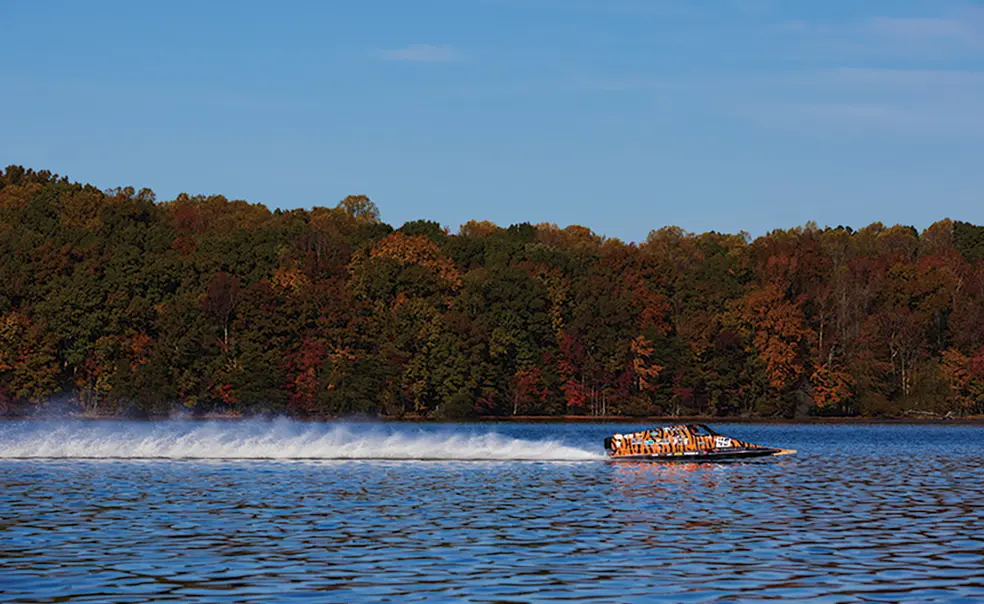The Princeton Electric Speedboating Club Broke a World Record
Big Bird’s 117 mph pace has raised the bar for electric speedboats
“Good morning everybody, and welcome to the livestream!”
On Oct. 26 — a clear, windless fall morning on Lake Townsend near Greensboro, North Carolina — Nathan Yates ’22 *23 welcomed viewers to an online livestream of “the world’s first ever electric boat kilometer record event,” and introduced them to its sole contestant, a 14-foot hydroplane called Big Bird.
The lake was glassy as a mirror, good conditions for challenging the unofficial record for the fastest electric speedboat: 116 mph, set by Vision Marine Technologies from Quebec.
The lake was empty, too, thanks to an obliging city government, which had closed it to all crafts except those affiliated with Princeton Electric Speedboating (PES). Buoys for the racecourse were set one kilometer apart.
“From the time it takes the boat to complete a lap, we can calculate the average speed of a boat across one kilometer. The average of the two laps’ speeds is the official speed of the record run.”
Big Bird is shaped more like a lobster, actually, thanks to two front stabilizers called sponsons. Twenty minutes before her record attempt, she sat parked on a boat ramp while her team performed final inspections.
“Oxygen tank?” asked Nastassia Patnaik ’26, the keeper of the team’s pre-run safety checklist.
“Oxygen tank,” confirmed Andrew Robbins ’25, the PES team captain.
Big Bird’s custom-built battery rig had been swaddled with a heated blanket; to deliver maximum power, racing batteries need to be Goldilocks warm, not too hot and not too cold.
It was 9:53 a.m.
“The boat is in the water … .”
How’s this for speed? As a club, PES has grown from a faint idea to a legitimate world record challenger in just a little over three years.
The team formed during the pandemic haze of the 2020-21 school year. That was when the American Society of Naval Engineers (ASNE) sent out a call, via Princeton’s engineering listserv, for entries in a collegiate electric boat rally. Yates and four of his schoolmates decided to go for it — even though they were scattered across the country.
Each team member built a different part of the boat at home — in California, in Rhode Island, in Oregon, in New Jersey. At the race site, they pulled back-to-back all-nighters, soldering furiously, to put the craft together.
Unfortunately, the team member who had designed the boat’s electrical system was the only one who actually knew how to operate it. And he was 6-foot-9. It was an exceedingly tight fit; and what’s more, the hull design turned out to be inadequate for the heavy drivetrain.
“The boat ran,” Yates clarified. “But we started taking on water pretty quick.”
Today, PES has around 40 active student members, 18 sponsors, three boats, and one ASNE college championship title, which they won with Robbins in the cockpit, racing at an average pace three times faster than their closest competition.
For this record try on Lake Townsend, PES has a different captain at the helm, a professional racer named John Peeters. With several gas-engine boating world records under his belt, Peeters knows how to handle dangerous speeds. People can die racing top-speed powerboats — which is what the Princeton team believed Big Bird was, even if the crew had never pushed the boat to its absolute limits.
Electric motors, in particular, come with safety concerns. “With battery management systems, they’re very finicky. If you do something a bit wrong, it’ll explode pretty violently,” said Silas Mohr ’24.
And then, Mohr added, there were the mechanical parts, various pins and shafts and bars. If they broke unexpectedly, no one would get hurt, but any record try would be torpedoed.
In deference to this latter category of fluke malfunction, the team had begun to knock on wood.
“Sailors are just superstitious, right?” said Bobby Diaz ’26.
As far as good luck went, the Princeton team’s biggest boon was the arrival of Robbins in 2021. He came to campus from Port Huron, Michigan, and grew up working on powerboats. But he hadn’t known about Princeton’s team until he came across their booth at the freshman activities fair. “Looking back,” Robbins said, “it’s really incredible.”
Right before the first time trial, Diaz saw a heron by the lakeshore. “It’s a literal Big Bird!” he said. He saw that as a good sign.
Diaz also liked what he saw of Big Bird’s run from his perch on a pontoon boat. Everyone did. “See that air underneath? That’s beautiful,” said a race official on the boat.
Preliminary reports indicated an average of 111 mph on first lap.
The second lap: 117 mph. “We beat Vision Marine on the second pass!” said Diaz. Back on shore, the team hugged, whooped, and high-fived.
Two hours later, on the second run, Big Bird’s propellor shaft — a standard, off-the-shelf part — broke unexpectedly. Big Bird glided to a halt. There would be no more record tries in North Carolina. “There was so much torque,” Robbins explained in the immediate aftermath, when people weren’t talking much.
An hour later, after Yates had sprayed them all down with champagne, most were laughing and clapping again. Were they lucky? Their propellor shaft had failed, but on the second run, and not the first. That was a kind of good luck, wasn’t it? A luckily timed unlucky break.
“We broke the record, we’re faster than anybody’s ever gone, and the boat’s in one piece,” Robbins said. “I think that’s a win!”












No responses yet